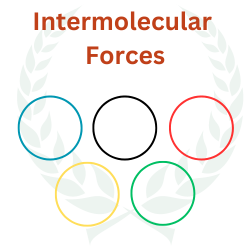| Types of Interactions | Shown By | Energy (KJ/mole) | Examples (Image) |
|---|---|---|---|
| Ion-Ion | Only Ions (E.g.- Na+Cl- or carboxylate ion and ammonium ion) | 400-4000 |  |
| Ion-Dipole | Ion and Polar molecules (E.g., Na+ and H2O) | 40-600 |  |
| Ion-Induced Dipole | Ion and Nonpolar molecules (E.g., Na+ and H2) | 3-15 |  |
| Hydrogen Bonding | Only highly electronegative atoms N, O, or F.
The Hydrogen bond is electrostatic, bridging two electronegative atoms (N, O, or F) using Hydrogen, one to which the Hydrogen is covalently bound. (E.g., H-O δ--H δ+… δ-O-(H)2, Fδ--Hδ+...F- or ketone and alcohol)
| 20-165 |  |
| Dipole-Dipole (Keesom) | Polar molecules (E.g., HClδ- - δ+HCl or between two CO2) | 5-25 |  |
| Dipole -Induced dipole (Debye) | Polar and Nonpolar molecules. (E.g., Hδ+Clδ- and He or alcohol and benzene) | 2-10 |  |
| Induced Dipole- Induced Dipole (London Forces) | It is a universal force. Other forces exist in addition to London forces in molecules. (E.g., condensation of inert gases with no other interfering functional groups is the most basic example of London forces - Liquefaction of He gas by He-He interactions. Another example is the interaction between two nonpolar benzene molecules). | 0.05-40 |  |
Intermolecular forces are essential as they play an important role in affecting various aspects of organic and biological chemistry. They influence the shape of molecules, reaction rates, physical properties, and even enzymatic reactions. The chapter on Intermolecular Forces, part of the Introductory Organic Chemistry course, covers intermolecular interactions like ion-dipole, ion-induced dipole, Hydrogen bonding, and Vander Waal forces (Debye, Keesom, and London). In addition, the chapter Bonding in Atoms covers other interactions like ionic, covalent, and metallic.
Related Reading – Intermolecular Forces, Bonding in Atoms
